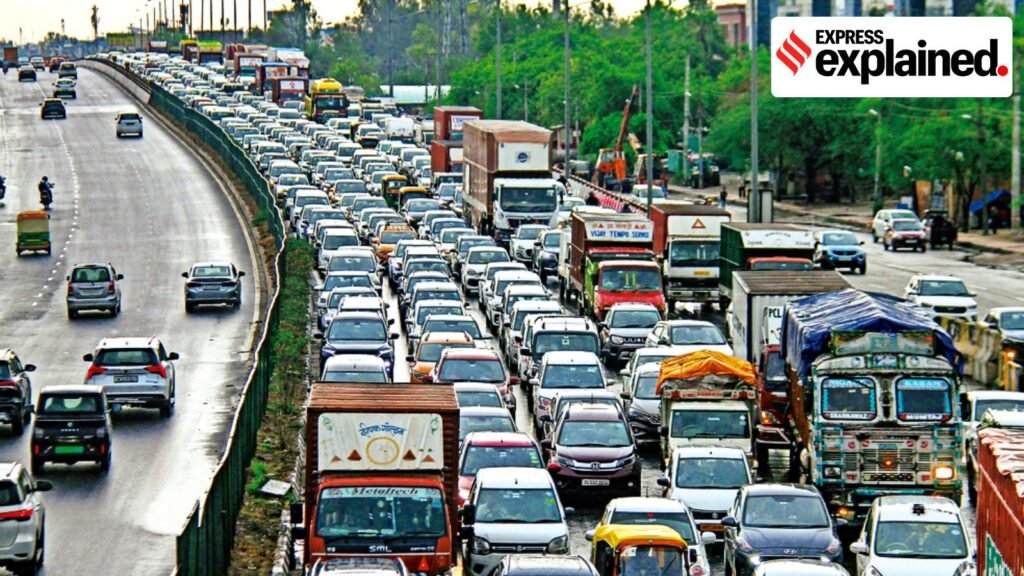
Two days after fuel pumps in Delhi began refusing petrol and diesel to vehicles older than their mandated lives, the state Environment Minister urged the air quality watchdog for the National Capital Region (NCR) to pause the implementation of the policy, citing “operational and infrastructural challenges”.
The directive from the Commission for Air Quality Management (CAQM), intended to force end-of-life vehicles (ELVs), a major source of vehicular pollution, off the roads, is grounded in long-standing court orders and strong environmental concerns.
What is Delhi’s ‘fuel ban’ for old vehicles?
As of July 1, diesel vehicles older than 10 years and petrol vehicles older than 15 years cannot legally get fuel in Delhi’s fuel stations.
In April, the CAQM directed a phased denial of fuel to ELVs at fuel stations in the NCR — in Delhi from July 1, in high-density NCR districts from November 1, and in the rest of the NCR from April 1, 2026.
Delhi has installed Automatic Number Plate Recognition (ANPR) cameras at 498 fuel stations — 382 petrol/diesel and 116 CNG filling stations — and three inter-state bus terminuses (ISBTs) to scan vehicle number plates and check them against the VAHAN database, India’s national vehicle registry, in real time.
An audio alert plays when the scan detects an ELV at the fuel pump. The overage vehicle is denied fuel, and may be impounded and sent for scrapping unless valid exemptions or required documents are presented.
Teams comprising personnel from the Delhi government’s Transport Department, Delhi Traffic Police, and civic bodies have been put together to enforce the CAQM directive.
Story continues below this ad
However, enforcement has been slack. On July 1, 80 vehicles were seized, but this number fell to seven on July 2. No vehicles were impounded on Thursday and Friday.
What is the reason for the Delhi government’s lack of enthusiasm?
In a letter written to the CAQM on Thursday, Delhi Environment Minister Manjinder Singh Sirsa said “immediate implementation” of the directive “may be premature and potentially counterproductive”.
There were problems with the ANPR-based enforcement system, including “technological glitches, camera placement, sensors not working, [and] speakers not functioning”, Sirsa said. Also, “the system is unable to identify EOL (end-of-life) vehicles where there are issues related to HSRPs (the new high-security registration plates).”
The lack of integration with the vehicle data of NCR states may encourage “vehicle owners procuring fuel from adjacent districts…thereby circumventing the ban”, Sirsa said. These “technological inconsistencies” were leading to “public discontent and outcry”, the Minister said.
Story continues below this ad
How many vehicles are affected by the watchdog’s directive?
According to the VAHAN database, there are nearly 62 lakh ELVs in Delhi — 41 lakh two-wheelers, 18 lakh four-wheelers, and the rest comprising goods carriers and commercial vehicles. The NCR districts in Haryana account for 27.5 lakh ELVs, those in Uttar Pradesh for 12.4 lakh, and those in Rajasthan for 6.1 lakh.
What is the problem with older vehicles, if owners keep them in good condition?
Authorities argue that pre-BS-VI (Bharat Stage VI) vehicles are disproportionately responsible for vehicular emissions. BS-IV vehicles, for instance, emit 4.5 to 5.5 times more particulate matter than BS-VI vehicles. BS-VI emission norms were mandated from April 1, 2020 onward.
Transport emissions account for 28% of PM2.5, 41% of sulphur dioxide (SO2), and 78% of nitrogen oxide (NOx) emissions in the NCR, according to official estimates. According to the CAQM, the transport sector’s contribution to air pollution in Delhi “needs no emphasis”.
Although legal mandates have existed since 2015, officials say enforcement was delayed due to the absence of necessary technological infrastructure.
Story continues below this ad
“The liquidation of such (overage) vehicles can only be done by adopting strict steps like denying fuel. These measures will help improve air quality,” Dr Virender Sharma, Member-Technical at CAQM, has said.
What is the legal mandate for the CAQM’s fuel ban?
In 2015, the National Green Tribunal (NGT) directed: “All diesel vehicles (heavy or light) which are more than 10 years old will not be permitted on the roads of Delhi NCR.”
Also, “Petrol vehicles which are more than 15 years old and diesel vehicles that are more than 10 years old shall not be registered in the NCR, Delhi,” the NGT said.
The NGT’s directive was upheld and reinforced by the Supreme Court in 2018. It said that vehicles violating the order should be impounded.
Story continues below this ad
Last year, Delhi framed guidelines under the Motor Vehicles Act and the Registered Vehicle Scrapping Facilities (RVSF) Rules. Most recently, the Environment Protection (End-of-Life Vehicles) Rules, 2025, effective April 1, made scrapping mandatory within 180 days of the expiry of the vehicle’s registration.
Age caps are not a new idea. The Motor Vehicles Act, 1988, says the registration certificate for any motor vehicle other than a transport vehicle “shall…be valid only for a period of fifteen years from the date of issue and shall be renewable”.
The Central Motor Vehicles Rules, 1999, say after the “period of validity entered in the certificate of registration” expires, the vehicle “shall not be deemed to be validly registered”.
Can measures such as these resolve Delhi’s bad air problem?
No single strategy is sufficient, experts have said. The solution lies in coordinated planning and action on multiple fronts, involving a wide range of stakeholders.
Story continues below this ad
On Thursday, the prominent environment policy think tank Centre for Science and Environment (CSE) said placing an age cap is “not a scalable strategy for the entire country”. It pointed out that “grossly polluting vehicles can also fall under different or newer age brackets due to inherent technical problems and lack of maintenance”.
CSE has pushed for the “improvement of fuel and emission standards”, a “stringent Pollution-under-Control regime”, and a “massive augmentation of public transport”.





